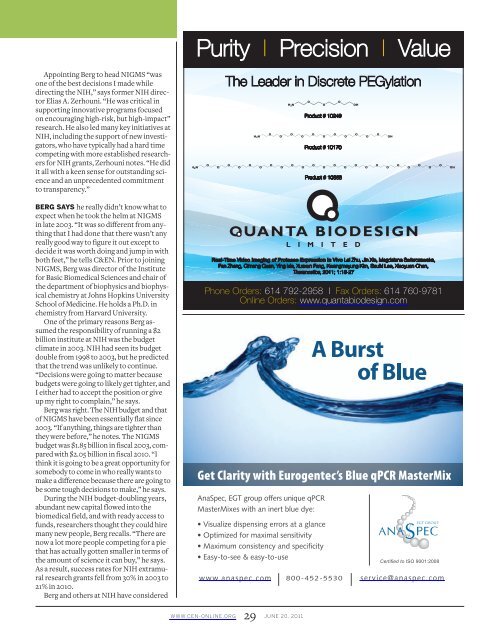GOVERNMENT & POLICYPETER CUTTS PHOTOGRAPHYIN OVERDRIVE Berg tiesup loose ends at his office,where molecular modelshang from the ceiling.JEREMY BERG’SLEGACY AT NIHNIGMS director, CHAMPION OF CHEMISTRYleaves an indelible markBRITT E. ERICKSON, C&EN WASHINGTONONE OF THE FOREMOST advocates forchemistry at the National Institutes ofHealth is stepping down at the end of thismonth. Jeremy M. Berg, director of theNational Institute of General Medical Sciences(NIGMS), the top NIH institute forthe support of chemical research, is takinga position at the University of Pittsburgh,where his wife, Wendie Berg, is a breastimagingexpert.NIH has been seeking a replacement forBerg since he announced last Decemberthat he would be leaving (C&EN, Dec. 13,<strong>20</strong>10, page 8). But when C&EN went topress, no one had been named to the positionyet. NIH announced on <strong>June</strong> 13 thatJudith H. Greenberg will serve as actingdirector of NIGMS while the search for apermanent director continues.Berg, a chemist to the core, will indeedbe hard to replace. During his seven-anda-half-yeartenure at NIGMS, he helpedincrease funding for new investigators andhighly innovative biomedical research. Hespearheaded the drafting of NIGMS’s firststrategic plan and strived to boost trainingof extramural researchers funded byNIGMS. He also helped increase diversityin the biomedical workforce.Berg is widely admired for his leadershipand communication skills. He is particularlywell-known for successfully finding middleground between NIH and the AmericanChemical Society in <strong>20</strong>04, when NIH decidedto launch PubChem, a publicly accessiblechemical structure database. Officialsof ACS, which publishes C&EN, initially opposedthe idea, worried that the free servicewould compete with their private database,the Chemical Abstracts Service Registry.NIH Director Francis S. Collins recallsworking closely with Berg on the PubChemproject during negotiations with ACS. Atthe time, Collins was director of the NationalHuman Genome Research Institute.WWW.CEN-ONLINE.ORG 28 JUNE <strong>20</strong>, <strong>20</strong>11The project, he says,“turned out to be a positivefor everyone, even itsoriginal opponents.”PubChem was a complexissue that createdsome tension, adds GlennS. Ruskin, director of theACS Office of Public Affairs.Berg “played a veryimportant role in helpingthe two organizations talkto each other.”Earlier this year, ACShonored Berg with its <strong>20</strong>11Public Service Award forhis vision and leadership in science policy(C&EN, April 25, page 9). Berg is also therecipient of the <strong>20</strong>11 Howard K. SchachmanPublic Service Award from the AmericanSociety for Biochemistry & Molecular Biologyand was recently elected as ASBMB’snext president, starting on July 1, <strong>20</strong>12.“We are delighted to have such an outstandingleader take the helm of ASBMBnext year,” says Suzanne Pfeffer, ASBMB’scurrent president and a biochemist at StanfordUniversity. “Berg brings tremendousexcellence in biochemistry and firsthandknowledge of the inner workings of NIHand key science policy issues.”Other scientific societies also praiseBerg for his accomplishments as a scientistand as a leader. “Berg is an extremelybright, confident, and creative scientist,and he used these talents well in his leadershipof NIGMS,” says Howard H. Garrison,deputy executive director for policy anddirector of the Office of Public Affairs atthe Federation of American Societies forExperimental Biology. “Open to a widerange of views, he encouraged an honestexchange of perspectives and was alwayswilling to engage with the extramuralcommunity. He did not shrink from big orcontentious challenges and often took boldsteps to confront them.”“He did not shrink from big orcontentious challenges and oftentook bold steps to confront them.”
Purity I Precision I ValueAppointing Berg to head NIGMS “wasone of the best decisions I made whiledirecting the NIH,” says former NIH directorElias A. Zerhouni. “He was critical insupporting innovative programs focusedon encouraging high-risk, but high-impact”research. He also led many key initiatives atNIH, including the support of new investigators,who have typically had a hard timecompeting with more established researchersfor NIH grants, Zerhouni notes. “He didit all with a keen sense for outstanding scienceand an unprecedented commitmentto transparency.”BERG SAYS he really didn’t know what toexpect when he took the helm at NIGMSin late <strong>20</strong>03. “It was so different from anythingthat I had done that there wasn’t anyreally good way to figure it out except todecide it was worth doing and jump in withboth feet,” he tells C&EN. Prior to joiningNIGMS, Berg was director of the Institutefor Basic Biomedical Sciences and chair ofthe department of biophysics and biophysicalchemistry at Johns Hopkins UniversitySchool of Medicine. He holds a Ph.D. inchemistry from Harvard University.One of the primary reasons Berg assumedthe responsibility of running a $2billion institute at NIH was the budgetclimate in <strong>20</strong>03. NIH had seen its budgetdouble from 1998 to <strong>20</strong>03, but he predictedthat the trend was unlikely to continue.“Decisions were going to matter becausebudgets were going to likely get tighter, andI either had to accept the position or giveup my right to complain,” he says.Berg was right. The NIH budget and thatof NIGMS have been essentially flat since<strong>20</strong>03. “If anything, things are tighter thanthey were before,” he notes. The NIGMSbudget was $1.85 billion in fiscal <strong>20</strong>03, comparedwith $2.05 billion in fiscal <strong>20</strong>10. “Ithink it is going to be a great opportunity forsomebody to come in who really wants tomake a difference because there are going tobe some tough decisions to make,” he says.During the NIH budget-doubling years,abundant new capital flowed into thebiomedical field, and with ready access tofunds, researchers thought they could hiremany new people, Berg recalls. “There arenow a lot more people competing for a piethat has actually gotten smaller in terms ofthe amount of science it can buy,” he says.As a result, success rates for NIH extramuralresearch grants fell from 30% in <strong>20</strong>03 to21% in <strong>20</strong>10.Berg and others at NIH have consideredThe Leader in Discrete PEGylationProduct # 10249Product # 10170Product # 10868Real-Time Video Imaging of Protease Expression In Vivo Lei Zhu, Jin Xie, Magdalena Swierczewska,Fan Zhang, Qimeng Quan, Ying Ma, Xuexun Fang, Kwangmeyung Kim, Seulki Lee, Xiaoyuan Chen,Theranostics, <strong>20</strong>11; 1:18-27Phone Orders: 614 792-2958 I Fax Orders: 614 760-9781Online Orders: www.quantabiodesign.comWWW.CEN-ONLINE.ORG 29 JUNE <strong>20</strong>, <strong>20</strong>11
















